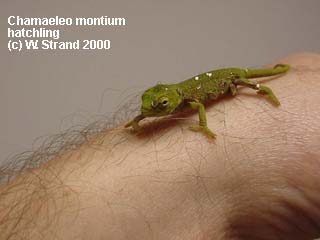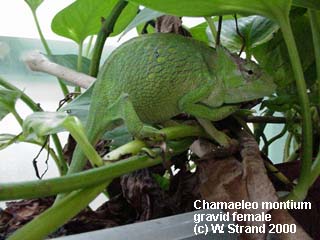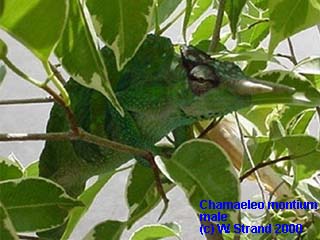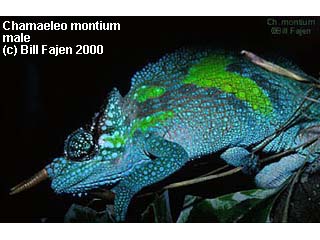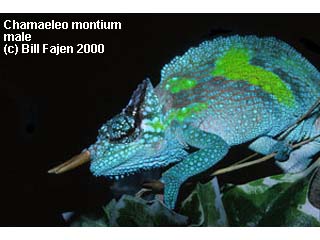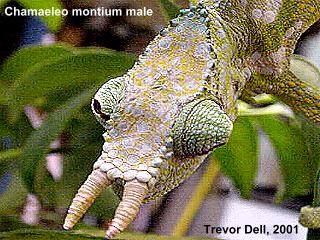The Mountain Chameleon is indigenous to Cameroon where it inhabits lower to mid-elevation mountain watersheds and montane cloud forests. Males grow to 10 inches (TL). Females grow to 8 inches. They are typically quite aggressive toward
conspecifics but shy toward keepers.
This species has long rostral horns projecting straight forward along the lower snout, a high, distinctly scalloped dorsal crest, and an even higher sailfin tail. The primary body shading can vary from neon to dark forest green or blue with gravid females often showing red skin between the green scales. Males in display sport bright blue, lime green and yellow spots along the head and shoulders. Both sexes have large plate-like "disk" scales along the body which vary in color from orange, to pale green, to sky blue. Males often have a yellow stripe with blue edges running diagonally from the middle of the back to the abdomen. Mature individuals reach an average (snout to tail tip) length of 5" to 10" for males. Females possess conical "horn-bud" scales but no horns. Males possess the high scalloped dorsal crest and the high tail fin, as well as the bright "display" colors. Females are smaller in size.
If parasites are treated correctly and if environmental preferences are met, WC montiums can be a hardy captive for the experienced chameleon keeper. 100% humidity is required for this species as well as constant daytime hydration by humidifier, drip, and/or spray/mist. Daytime temperatures should be approximately 75ºF with a basking area of around 85ºF, and as high as 90ºF, and no more than a 20 degree drop at night. Individual caging should be maintained, with cages densely planted and well lit with fresh UV bulbs. This species can be very shy, and if approached too quickly or closely, have a tendency to "drop and run", blackening, turning flips or hiding in corners on the ground. Most prey insects are accepted by this species and they are good hunters, so bowl feeding should be discouraged. Males in particular appear to be sensitive to over-supplementation, so care in use should be taken with these products. Instead, the keeper should rely on a nutritious diet for feeder insects.
Reproduction in captivity may be difficult as the males are sometimes reluctant to breed. By keeping the female physically and visually separate and then introducing her when she is receptive, and by cooling the cage and increasing hydration/humidity, the male be encouraged to court and copulate. Once gravid, the female assumes darker colors; gestation is 2 - 3 months. Females should be supplied with a proper laying site, as they are not particular about where they lay 5-25 eggs, and will lay them anywhere. Two -3 clutches may be laid in a single year. Incubation is approximately 21 weeks. Incubation temperatures have been reported as successful in a wide range, from 60ºF to 90ºF. The most commonly recommended temperature is around 75ºF with a few degrees drop at night. Babies often hatch "en mass' and with eager appetites. Sexual maturity is reached at approximately 6 months.
Contributed by Susan James
References
Davison, Linda J. 1997.
Chameleons: Their Care and
Breeding. Hancock House Publishers, Blaine, WA
Klaver, C. & W. Boehme. 1997. Chamaeleonidae.
Das Tierreich, 112: i-xiv' 1 - 85. Verlag Walter de Gruyter & Co., Berlin, New York.
Le Berre, F. 1994. The New Chameleon Handbook. Barron's Educational Series.
Martin, J., 1992. Masters of Disguise: A Natural History of Chameleons. Facts On File, Inc., New York, NY.
Necas, P. 1999. Chameleons: Nature's Hidden Jewels. Krieger Publishing Company, Malabar, FL.

